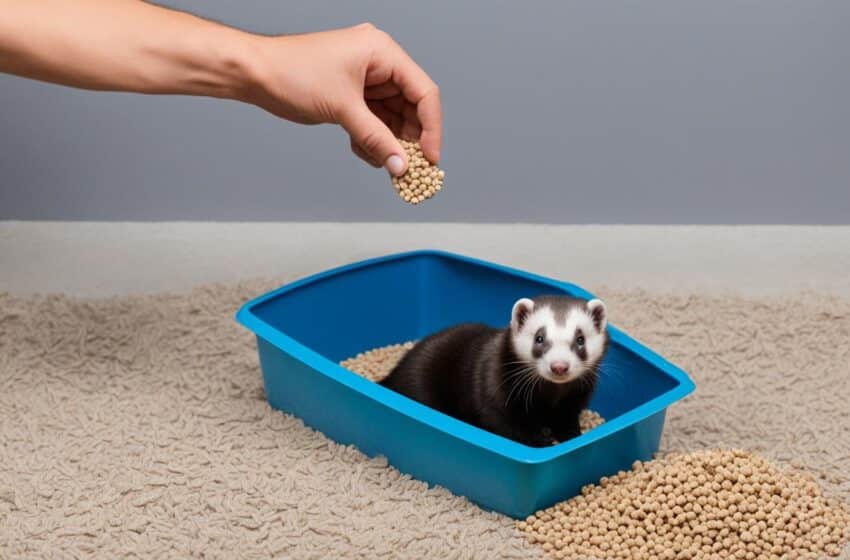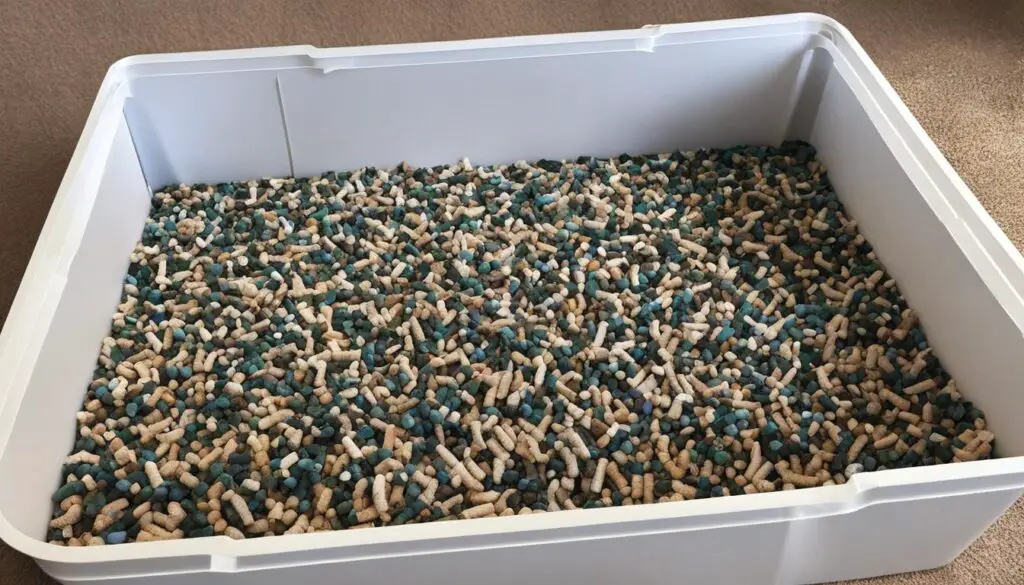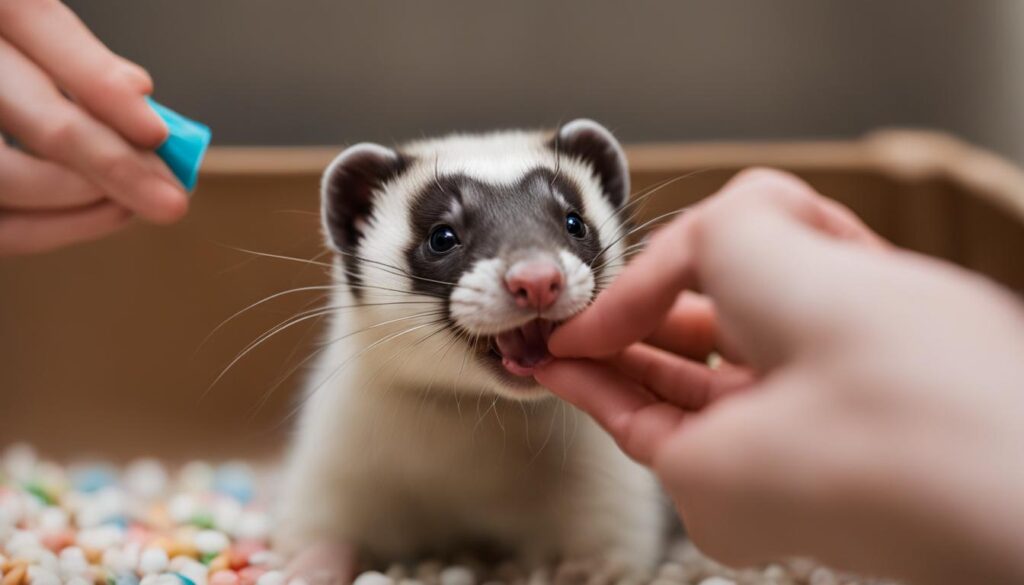Training Your Ferret to Use a Litter Box

Ferret owners often struggle with litter box training their pets. However, with some patience and consistency, it is possible to successfully train a ferret to use a litter box. Here are some tips and techniques to help you simplify your pet care and maintain a clean and happy ferret home.
Key Takeaways:
- Ferret litter box training requires patience and consistency.
- Understanding ferret behavior is crucial for successful training.
- Choose the right litter box and litter material for your ferret’s needs.
- Introduce your ferret to the litter box gradually and encourage positive associations.
- Reinforce good litter box habits with praise and treats.
Understanding Ferret Behavior
Before starting the litter box training process, it’s essential to understand ferret behavior and their natural instincts. By gaining insight into how ferrets behave, you can better tailor your litter box training approach and set your furry friend up for success.
“To truly train a ferret, we must first understand how their minds work.”
Ferrets have specific toilet habits that are important to consider during litter box training. One common behavior is their inclination to back into corners when relieving themselves. Understanding this behavior can guide your choice of litter box and litter materials.
Choosing the Right Litter Box
Selecting an appropriate litter box for your ferret is crucial. Opt for a box with square corners, as these provide a comfortable and secure space for your ferret to back into while using the litter box. A well-chosen box can make all the difference in successfully training your ferret to use it consistently.
Choosing the Right Litter Material
The type of litter material you use is equally important. Avoid scented litters or those with excessive dust, as they can irritate your ferret’s respiratory system. Pellets and small pearl-type litters are generally recommended for ferrets due to their absorbency and ease of cleaning.
A Peek into Ferret Toilet Habits
| Behavior | Explanation |
|---|---|
| Back into corners | Ferrets have a habit of backing into corners, making litter box design and placement in their enclosure critical. |
| Multiple bathroom areas | Ferrets may establish multiple bathroom spots in their living area, so placing multiple litter boxes can be beneficial. |
| Burying behavior | After relieving themselves, ferrets may exhibit a tendency to “dig and bury” their waste, mimicking their wild instincts. |
Understanding these common ferret toilet habits will help you anticipate their needs and create a litter box environment that aligns with their natural behavior.
Now that we have a deeper understanding of ferret behavior, we can proceed to the next step: choosing the right litter box and litter material for successful litter box training.
Choosing the Right Litter Box and Litter Material
When it comes to selecting a litter box for your ferret, there are a few key factors to consider. Firstly, opt for a litter box with square corners. Ferrets have a natural inclination to back into corners when they need to relieve themselves, so a litter box with square corners will mimic their preferred bathroom spot. This will make it easier for your ferret to use the litter box consistently.
Another important aspect to consider is the size of the litter box. It should be appropriate for your ferret’s size, allowing them to comfortably enter and exit the box. A litter box that is too small can make your ferret feel confined and result in them avoiding the litter box altogether. On the other hand, a litter box that is too large may make it difficult for your ferret to find their preferred bathroom spot.
When it comes to choosing the right litter material for your ferret, it’s crucial to avoid scented litters or those with a lot of dust. Ferrets have sensitive respiratory systems, and these types of litter can irritate their lungs and cause respiratory problems. Instead, opt for litter materials such as pellets or small pearl-type litters, which are generally recommended for ferrets. These materials are less likely to produce dust and are safer for your fur baby.

Choosing the right litter box and litter material for your ferret is crucial for successful litter box training. By providing a litter box with square corners and the appropriate size, as well as using suitable litter material, you create an environment that encourages your ferret to use the litter box consistently and comfortably.
Introducing Your Ferret to the Litter Box
To successfully train your ferret to use a litter box, it’s crucial to introduce them to the concept in a positive and consistent manner. Here are some effective techniques for getting your ferret comfortable with their new bathroom routine.
- Timing is key: After your ferret finishes a meal, gently place them inside the litter box. This will help them associate the box with their bathroom needs and create a routine for toileting.
- Fecal matter encouragement: To encourage your ferret to use the litter box, sprinkle some pieces of their own fecal matter inside. Ferrets have a strong scent drive, and the smell will help them recognize the litter box as the appropriate place for elimination.
Remember, patience and love are vital throughout the training process. Some ferrets may take longer to grasp the concept of litter box use, so it’s important to remain consistent and supportive.
“Consistency and positive reinforcement are key when introducing a ferret to the litter box. With patience and love, you’ll soon have a ferret that’s happily using their designated bathroom spot.” – Ferret Expert
Reinforcing Good Litter Box Habits
Once your ferret starts using the litter box regularly, it’s important to reinforce their good behavior to ensure consistent habits. Positive reinforcement is key to creating a happy and hygienic environment for your furry friend.
One effective way to reinforce good litter box habits is through verbal praise. When you see your ferret using the litter box, praise them with a cheerful and encouraging tone. This simple act of acknowledgement can go a long way in reinforcing their understanding of the desired behavior.
Additionally, offering small treats can serve as a positive reinforcement for your ferret’s litter box success. Choose healthy treats specifically made for ferrets and reward them immediately after they use the litter box. This will create a positive association between the action and the reward, further motivating your ferret to continue using the litter box consistently.
It’s important to note that accidents happen, especially during the early stages of litter box training. If your ferret has an accident outside the litter box, it’s crucial to avoid scolding or punishing them. This can create fear or anxiety and hinder their progress in using the designated bathroom spot.
Instead, calmly clean up the mess using pet-friendly cleaning products and dispose of any soiled bedding or litter. Place these items in the litter box to help reinforce the desired behavior. This will remind your ferret of the appropriate place to go to the bathroom, without causing any negative associations or stress.
Remember, patience and consistency are key when reinforcing litter box habits. Celebrate your ferret’s successes, provide gentle guidance for accidents, and create a positive and stress-free environment for their training journey.

Troubleshooting Litter Box Issues
If your ferret is having recurring accidents or not using the litter box consistently, it is essential to examine possible reasons for these litter box problems. By identifying the underlying cause, you can implement effective ferret litter box solutions and handle ferret accidents appropriately.
Possible Causes of Litter Box Problems:
- Dirty Litter Box: A dirty litter box can discourage your ferret from using it. Regularly clean and change the litter to maintain cleanliness and freshness.
- Stress or Anxiety: Ferrets may avoid the litter box if they feel stressed or anxious. Assess your ferret’s environment for any potential stressors and provide a calm and soothing setting.
- Health Issues: Certain medical conditions, such as urinary tract infections or gastrointestinal problems, can lead to litter box problems in ferrets. If you notice any changes in your ferret’s behavior or health, consult with a veterinarian for a proper diagnosis and treatment.
By addressing these possible causes and implementing appropriate solutions, you can effectively handle litter box issues and improve your ferret’s litter box habits. Ensuring a clean and comfortable litter box, reducing stress, and addressing any potential health concerns will contribute to a successful litter box training experience.
Conclusion
Successful Ferret Litter Box Training is essential for a clean and hygienic ferret home. Through consistent training techniques and a strong understanding of ferret behavior, you can simplify your pet care routine and create a happy living environment for your furry friend.
Potty training your ferret may require some time and patience, but the rewards are well worth it. A properly litter-trained ferret will not only eliminate the hassle of cleaning up after accidents but also strengthen the bond between you and your pet. With regular training and positive reinforcement, you can teach your ferret to use the litter box consistently and avoid messes throughout your home.
Remember to choose the right size and type of litter box for your ferret’s needs. Square-cornered litter boxes are preferred as they mimic a ferret’s natural instinct to back into corners. Opt for litter materials that are safe and comfortable, such as pellets or small pearl-type litters. Avoid scented or dusty litters that can be harmful to your ferret’s respiratory system.
By investing your time and effort into Ferret Potty Training, you can maintain a clean and odor-free living space while promoting your pet’s well-being. Enjoy the benefits of a successful litter box training journey and create a harmonious home environment for both you and your beloved ferret companion.
FAQ
What can I do to train my ferret to use a litter box?
To train your ferret to use a litter box, you can start by understanding their behavior and choosing the right litter box and litter material. Then, introduce your ferret to the litter box, reinforce good behavior, and troubleshoot any issues that arise.
How do I understand my ferret’s behavior when it comes to using a litter box?
Ferrets tend to have specific toilet habits, such as backing into corners to do their business. Understanding this behavior will help you select the appropriate litter box and litter material for your ferret.
What should I consider when choosing a litter box and litter material for my ferret?
When selecting a litter box, opt for one with square corners as ferrets prefer to back into corners to relieve themselves. The size of the litter box should be appropriate for your ferret’s size, and for the litter material, avoid scented litters or those with a lot of dust, as they can be harmful to a ferret’s respiratory system.
How do I introduce my ferret to the litter box?
To introduce your ferret to the litter box, place them inside the box after meals to help them associate it with their bathroom routine. You can also sprinkle some pieces of ferret fecal matter into the litter box to encourage them to use it. Be patient and loving throughout the training process.
How can I reinforce good litter box habits in my ferret?
As your ferret starts using the litter box regularly, reinforce their good behavior by providing verbal praise or small treats. Avoid scolding or punishing your ferret if accidents happen outside the litter box, as this can create fear or anxiety.
What should I do if my ferret is having recurring accidents or not using the litter box consistently?
If your ferret is having recurring accidents or not using the litter box consistently, consider examining possible reasons such as a dirty litter box, stress, or health issues. Ensure the litter box is cleaned regularly, provide a calm environment, and consult with a veterinarian if necessary.



